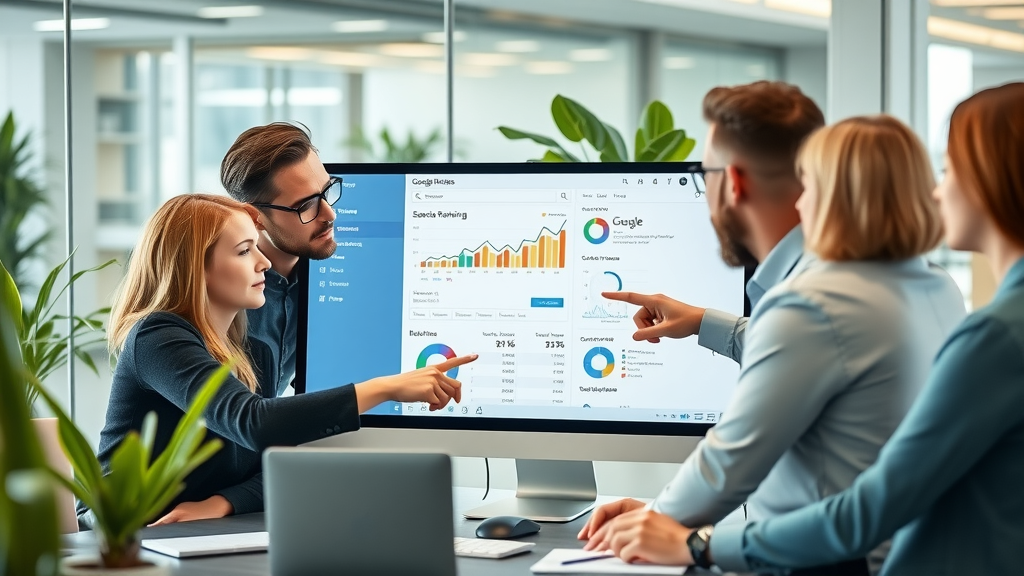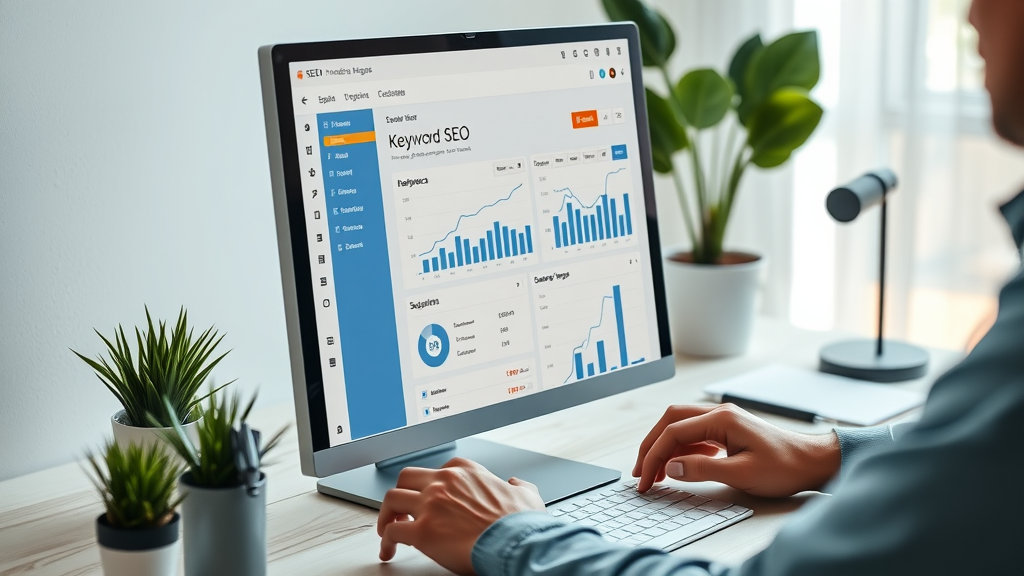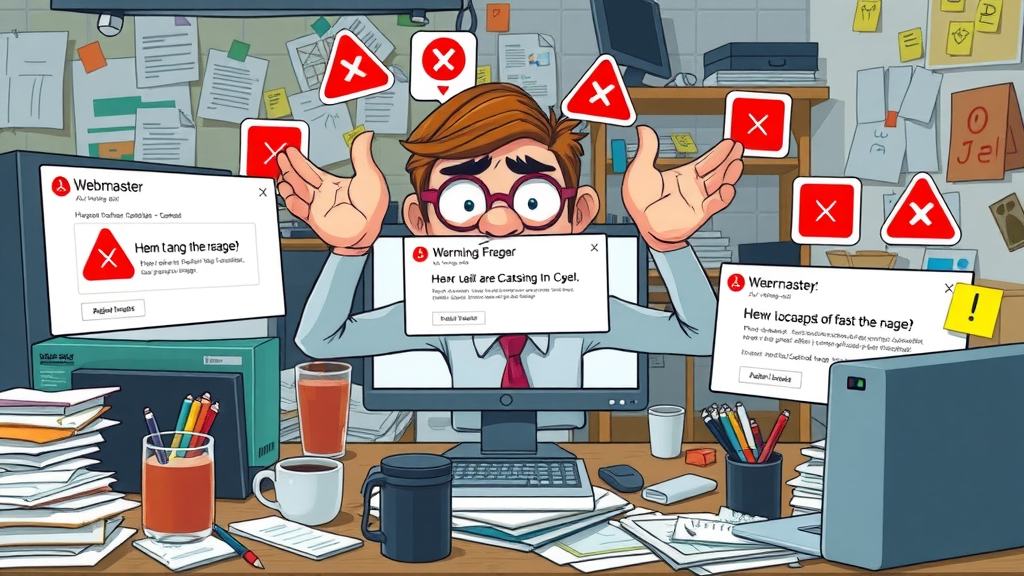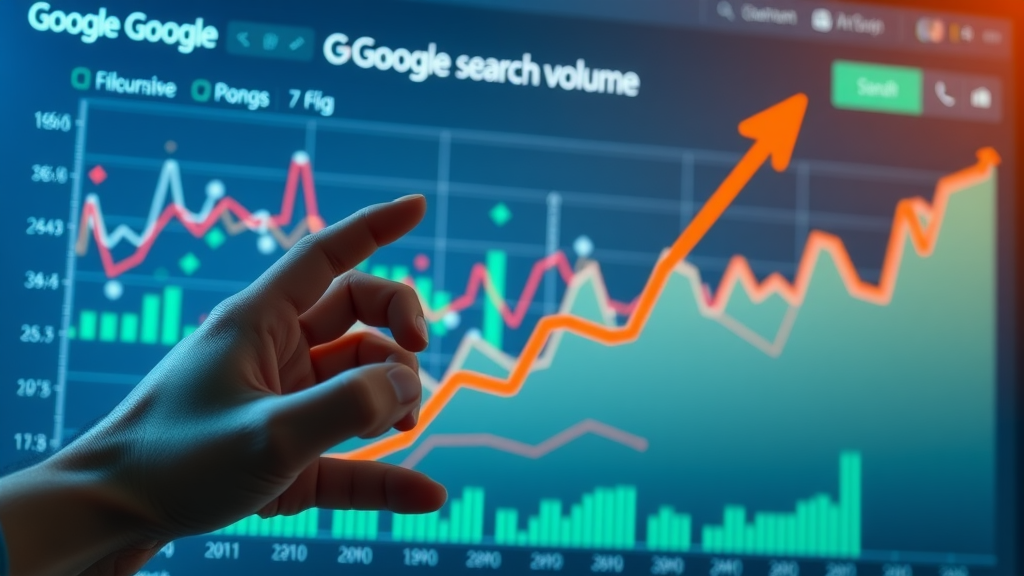"Over 90% of all web traffic goes to sites listed on the first page of Google. But only a fraction know what it really takes to rank higher on Google today."

Did you know that over 90% of internet users never venture beyond Google’s first page ? Getting to the top is the difference between a bustling website and a ghost town. Just last month, a local bakery grew from 5 walk-ins a week to 50, all thanks to mastering local SEO and learning how to rank higher on Google. Today, we’ll pull back the curtain—showing you the real secrets and easy-to-follow steps to boost your site fast , drive traffic, and truly rank higher on Google —no matter your niche. Your website’s transformation starts here.
What You’ll Learn
-
The must-know strategies to unlock how to rank on Google
-
On-page, off-page, and technical SEO secrets for ranking higher
-
Local SEO tips, mistake-proofing, and expert resources
-
Actionable steps to measure, monitor, and grow organic traffic
Unlocking How to Rank on Google: Key Secrets to Rank High Fast
Mastering how to rank on Google is the lifeblood of modern business. Securing those top spots is no longer just about stuffing a few keywords and waiting; it’s about understanding what works now . Businesses that focus on ranking high report steady growth, amplified organic traffic , and more qualified leads—whether you’re a solo entrepreneur or a large brand.
To rank higher on Google , you must address several core ranking factors . These include thorough keyword research , publishing quality content , and optimizing for both search engines and real users. For example, updating a blog post with new statistics and improving its page SEO can drive it from page three to the coveted top three spots. Don’t forget the critical role of technical SEO (like site speed and mobile-friendliness) and local SEO (for businesses serving specific areas). These technical tweaks and local signals set apart winners from the crowd.
Applying these actionable techniques not only boosts your position in Google rankings but also establishes your site as an authority in your field, significantly improving your google ranking and helping you rank higher on Google through effective page SEO and technical SEO strategies. From meta tags and schema markup to building backlinks and updating your business profile, every element matters in the climb to rank higher.
-
Why mastering how to rank on Google is crucial for modern business
-
Core ranking factors that influence your Google rankings
-
Actionable techniques for boosting organic traffic and ranking higher
-
Proven ways to optimize every page for search engines and users alike
-
Technical SEO and local SEO best practices for sustainable results
Understanding How to Rank on Google and Search Engine Algorithms

To truly master how to rank on Google , you need to understand the mechanics behind search engine algorithms . These algorithms analyze thousands of signals—including relevance, authority, and user experience—to decide where your page appears in search results . By aligning your approach with these evolving rules, you increase your chances of achieving lasting Google rankings .
Google’s chief focus is meeting search intent—delivering the most relevant result for every query to help you rank higher on Google. For instance, if someone searches for “how to bake chocolate cake,” Google will prioritize pages with detailed recipes, videos, and user reviews over thin, unrelated content. The better your page matches both the intent and the user’s needs, the faster you will rank higher on Google .
Key factors influencing your ranking high include topical relevance (is your page about the exact search term ?), authority (do other sites link to you?), and user experience (is your site fast and easy to navigate?). Focusing on these pillars ensures you’re not just chasing rankings, but building a sustainable SEO strategy .
The Anatomy of Google Ranking: What Influences How to Rank on Google
-
The role of search engine algorithms in determining rank high status
-
Why search intent matters for ranking higher
-
Overview of key Google ranking factors: relevance, authority, user experience
Google’s algorithms analyze your page to see if it answers the search intent behind a query. For example, a page optimized for “DIY garden ideas” should offer actionable tips, photos, and step-by-step guides—delivering value to both humans and bots. This kind of user-focused, comprehensive content is a recognized ranking factor and can earn coveted featured snippet placement.
Authority comes from earning quality backlinks and mentions from reputable sites in your niche. If industry leaders reference your advice in their blog posts or social media, your site’s perceived expertise and trustworthiness grow. Lastly, optimizing user experience—such as fast loading times and intuitive site navigation—keeps visitors engaged and signals to Google that your site deserves to rank higher .
"Crafting your content for the user, not just the search engine, is the true secret behind organic traffic growth and top rankings." – SEO Industry Expert
Proven On-Page SEO Techniques to Rank Higher on Google

On-page SEO forms the foundation of your page SEO strategy, essential for how to rank higher on Google effectively, improving your google ranking and boosting your organic traffic with quality content and optimized keyword research. It involves optimizing each page to improve its visibility in search results , boost organic traffic , and meet user expectations. Applying effective on-page techniques—such as careful keyword placement , meaningful internal linking, and mobile-friendly layouts—helps your content soar higher on Google.
A winning on-page SEO strategy is more than just sprinkling keywords. It’s about understanding search intent and matching your content structure, meta tags , and section headings to what real users seek. For example, updating your title tag and meta description with the main keyword can increase your click-through rate, while optimizing images with descriptive alt attributes ensures search engines—and users—understand your content more deeply.
Let’s dig into the critical building blocks: keyword research and mapping , quality content creation, and maximizing user experience. These not only improve your ranking factor scores but also delight your visitors—paving the way for long-term SEO success.
Mastering Keyword Research and Mapping for How to Rank on Google
-
How effective keyword research impacts Google rank
-
Tools to uncover keywords for higher on Google positioning
-
Matching content with search intent to climb Google rankings
Effective keyword research is ground zero for any successful Google ranking strategy and a critical ranking factor that drives organic traffic, improves your google rank, and enables you to rank higher on Google by aligning with search intent and using tools like Google Search Console. Begin by brainstorming core search terms your audience uses—then expand your list with SEO tools such as Google Keyword Planner, SEMrush, or Ahrefs. These platforms reveal how often people search for each term, how tough the competition is, and what questions or related phrases drive organic traffic .
Mapping keywords to specific pages is just as critical. Avoid targeting the same specific keyword on multiple blog posts, which can split your potential traffic. Instead, designate a “pillar” page for each main topic and build out related articles to support it, using smart internal links. This approach not only clarifies your site structure for search engines but also serves users better—making it easier for you to rank higher on Google for a range of relevant queries.
Most importantly, align each keyword with the right search intent . Match informational intent with comprehensive guides, commercial intent with product pages, and so on. This sharpens your content’s focus, increases dwell time, and dramatically improves your page’s rank high potential.
Quality Content Creation for Ranking High on Google
-
Importance of quality content and depth for ranking factor improvement
-
Guidelines for optimizing headers, subheaders, and meta tags using the main keyword
-
Frequently updated, original content as a pathway to rank high

Quality content is the most important ingredient in the recipe for ranking high on Google and improving your organic traffic. It’s not about word count, but the depth, value, and clarity you provide. Engage your readers with real-life examples, thorough explanations, and visuals that support your points—making sure every page answers a specific search intent .
Optimizing headers and subheaders is crucial for both users and search engines . Use the main keyword and related phrases in your H1 , H2 , and H3 tags, and weave the main topics naturally throughout your content. Don’t neglect your meta title and meta description—these appear in search results and influence clicks as much as rankings.
Top-ranking websites consistently update their blog posts to reflect the latest knowledge, trends, and facts. Regularly refresh outdated statistics, add new sections, and adjust your page SEO based on changing user needs. Frequent updates signal to Google that your site is active and authoritative—a recognized ranking factor that keeps your site higher on Google for the long haul.
|
|
|
Comparison of On-Page SEO Elements |
|
Element |
Best Practice |
SEO Impact |
|---|---|---|
|
Title Tags |
Include main keyword at the start, under 60 characters |
Increases relevance and CTR |
|
Meta Descriptions |
Clear summary with keywords, under 160 characters |
Boosts click-through from search results |
|
Header Tags (H1-H6) |
Structure content with keywords in headers |
Improves content hierarchy and keyword signaling |
|
Image ALT Attributes |
Describe image using relevant keywords |
Aids accessibility and image search rankings |
|
Internal Linking |
Link related pages with descriptive anchor text |
Increases authority and helps with crawling |
|
Keyword Placement |
Distribute main and related keywords naturally |
Ensures optimal search engine relevancy |
Maximizing User Experience for Higher on Google Rankings
-
Core web vitals and Google ranking
-
Mobile-friendliness and load speed as ranking higher drivers
-
Structuring your pages for optimal search engine and user experience
Google’s top-ranking sites excel in user experience, a critical ranking factor that significantly influences how to rank higher on Google, improve your google rankings, and increase organic traffic by optimizing site speed and mobile-friendliness. This goes beyond content—your site must be fast, mobile-friendly, and easy to navigate. Short loading times (under 2.5 seconds), clear layouts, and mobile optimization are now key ranking higher factors thanks to Google’s Core Web Vitals updates.
Even the best content falls flat if users struggle to find what they need or if your site looks broken on their phone. Test every page for responsiveness, reduce unnecessary scripts, and compress images for speed. Making these improvements not only pleases users but clearly signals to Google that your page is worthy of a higher spot in search results .
Structuring your pages with logic—using clear headings, bulleted lists, and concise paragraphs—helps both human readers and search engines digest your information efficiently. When your site is usable, fast, and accessible, it becomes easy to rank high and keep your audience coming back.
Technical SEO Tactics for Ranking Higher on Google Search

Technical SEO is the hidden engine powering your journey to rank higher on Google by ensuring your site is crawlable, indexable, and fully optimized for search engines, which is essential for improving your google ranking and overall page SEO. While users may never see your code or sitemap, search engines depend on this technical foundation to crawl, index, and evaluate your site. Without it, even the greatest content or linking strategy may not reach its full ranking potential.
Ensuring your website is properly crawlable and indexable is a must. Check your robots.txt, submit an updated sitemap in Google Search Console , and fix broken links to signal quality. Enhance your pages with structured data (schema markup), so your content is eligible for rich results—like reviews, FAQs, and event highlights—which set you apart in search results .
Don’t overlook security (using HTTPS), canonicalization for duplicate content, and correcting any crawl errors reported by Search Console. These technical signals reinforce trust and stability, helping push your page rank ahead of less-optimized competitors.
How Technical SEO Influences How to Rank on Google
-
Site crawlability, indexing, and how to detect technical SEO issues using Search Console
-
Structured data and schema markup for richer search engine results
-
HTTPS, canonicalization, and other critical technical SEO factors
When Google crawls your site, it looks for an open, well-organized structure. Regularly review Search Console for crawl errors, indexation issues, or mobile usability warnings that might keep key pages from showing up in search results . Implementing structured data annotates your content so Google understands and features it for the right search intent —enabling featured snippet wins and richer, more engaging listings.
Secure your site with an SSL certificate (HTTPS) and eliminate duplicate content using canonical tags. Canonicalization ensures that search engines credit the right page even if similar versions exist, boosting Google ranking without confusion. Stay consistent and systematic—these small adjustments go a long way in reinforcing every other SEO effort for ranking higher .
Technical SEO isn’t just about pleasing Google bots; it makes your site smoother, faster, and safer for everyone. This keeps users engaged and returning—two positive signals that help you rank higher on Google in the long term.
Using Search Console and Google Analytics to Monitor Google Rank Progress

-
Leveraging Google Search Console for actionable ranking insights
-
Tracking organic traffic and keywords with Google Analytics
-
Adapting your SEO strategy based on performance metrics
Once your page SEO improvements go live, it’s time to track their effect with Google Analytics and Google Search Console to monitor your google rank, ranking high progress, and organic traffic growth for sustained ranking higher on Google. Use Search Console to check which keywords drive traffic to your site, see your average Google rank , and spot technical issues before they hurt your Google rankings . Tracking organic traffic lets you spot the direct result of all your improvements.
Google Analytics is invaluable for examining bounce rates, session duration, and conversion paths. If you add a new section to a popular blog post and see increased time-on-page and engagement, you know your strategy is working. Regularly adapting your approach—instead of “set and forget”—lets you climb higher and stay at the top even as search trends evolve.
Use this data to reinforce what’s working (like new keyword placements or better content layouts) and fix what’s not (such as high exit rates or slow page speed). For the best results, combine insight from both platforms, so you’re always optimizing for what matters most: ranking high on Google and engaging your audience.
|
|
Common Technical SEO Issues vs. Solutions for Higher on Google Ranking |
|
Technical Issue |
Solution |
|---|---|
|
Broken links & crawl errors |
Fix or redirect using a site audit tool and Search Console |
|
Duplicate content |
Apply canonical tags to preferred versions |
|
Slow page speed |
Compress images, minify code, use caching/CDN |
|
Inconsistent mobile experience |
Implement responsive design & test with Google’s mobile-friendly tool |
|
Lack of HTTPS |
Install and configure an SSL certificate |
Off-Page SEO and Backlink Building to Rank Higher on Google
Developing an Authority-Driven Google Ranking Strategy
-
Why backlinks remain a core ranking high factor
-
Strategies for earning high-quality, relevant links for your site
-
The impact of mentions, citations, and business profile optimization

Backlinks remain a core ranking factor and the backbone of any serious Google ranking strategy, significantly influencing your ability to rank high, improve your google ranking, and boost organic traffic through authoritative off-page SEO. When other reputable websites link to your content, it signals to Google that your page is trustworthy and authoritative—a true ranking factor . However, focus on quality over quantity. Links from industry leaders and respected directories are far more valuable than dozens of low-quality or irrelevant sources.
Earning quality links requires a blend of business outreach, relationship building, and content excellence. Create unique studies, infographics, or expert guides that others want to reference. Guest posting on respected blogs, contacting reporters through HARO (Help A Reporter Out), and leveraging local partnerships all help build a healthy backlink profile to rank higher on Google .
Don’t forget mentions and citations. When your business profile appears consistently (with accurate name, address, and phone number) across the web, it increases trust and discovers your brand as a relevant resource. These off-page signals are a must for businesses serious about sustainable organic traffic and ranking higher .
Social Signals, Brand Building, and Organic Traffic Growth
-
The evolving role of social media and online reputation in Google rankings
-
Amplifying organic traffic through influencer outreach and content partnerships
-
Integrating off-page methods for ranking higher on Google
Although direct social signals may not officially factor into Google’s algorithms, a strong social media presence amplifies your reach and increases chances for shares, links, and organic mentions—which all boost your ability to rank high . Engaging with users, responding to reviews, and building your digital reputation promote authority within your audience and encourage natural backlinks from blogs and forums.
Influencer outreach and strategic content partnerships are effective ways to boost organic traffic . By allies with creators and thought leaders, your content gets seen by broader audiences—sometimes even earning coveted featured snippet positions. Remember: off-page efforts work best when integrated with a robust on-page foundation.
Over time, these methods don’t just help you rank higher on Google . They cement your authority and visibility, making you the go-to choice in your niche, both online and offline.
Local SEO Best Practices: How to Rank Your Profile and Listing Higher on Google
Optimizing Your Business Profile for Local Search

-
Steps to build a local SEO strategy that drives visibility
-
Claiming and optimizing your Google My Business listing
-
Local citations, reviews, and their impact on local ranking high on Google
For businesses with a physical location or serving a specific area, local SEO is a crucial game-changer that helps your business profile rank higher on Google, improve local SEO visibility, and attract targeted local organic traffic by optimizing your business profile and local citations. First, claim and fully optimize your Google My Business profile—fill in every detail, add up-to-date photos, and use relevant categories. This ensures your business appears in the coveted “local pack” for near-me searches and maps queries.
Local citations—mentions of your business on directories and local sites—must be consistent. Inaccurate info can confuse Google and hurt your rankings. Encourage happy customers to leave reviews on your Google listing; reviews build trust, improve click-throughs, and influence your local business profile’s prominence.
The more trusted, complete, and active your local profile, the better your visibility when customers search for local services or solutions in your niche. For small businesses, this difference is night and day.
"A well-optimized local profile can mean the difference between being found and being forgotten in 'near me' searches." – Local SEO Specialist
Common Mistakes That Keep Sites from Ranking Higher on Google
-
Ignoring technical SEO vulnerabilities and slow site speed
-
Lack of keyword research and poor on-page SEO
-
Thin, duplicate, or low-quality content hurting your Google ranking
-
Overlooking local SEO and business profile inaccuracies

Many websites struggle to rank higher on Google not due to lack of effort but because of common SEO missteps, including neglecting technical SEO, poor keyword research, and weak on-page SEO, all critical ranking factors that impact your google ranking. Ignoring technical SEO —such as unresolved crawl errors or slow loading times—can render even excellent content invisible in search results . Always address technical red flags promptly using regular audits and tools like Google Search Console.
Another frequent pitfall is weak keyword research and lazy on-page SEO. Publishing content without clarity about search intent or competitive phrases leaves your pages out of sync with what users and search engines want. Similarly, low-quality, duplicated, or overly “thin” blog posts can get penalized or ignored entirely.
Local businesses often overlook their local SEO efforts, leaving business profiles outdated or inconsistent and missing out on crucial reviews or citations. Keeping every element polished and current is vital if you want to consistently rank high and grow your organic traffic .
Advanced Strategies to Rank Higher on Google Search
Content Silos, Internal Linking, and Structured Content for Ranking High
-
Why structuring your site in silos aids both users and search engines
-
Internal linking strategies that reinforce page SEO and rank higher intent
-
Using schema and advanced SEO tactics to stand out in rich snippets

Creating content silos (themed topic clusters) helps both visitors and search engines navigate your site intuitively, boosting your page SEO and your ability to rank higher on Google by improving internal linking and topical relevance. Start with broad “pillar” content—like 'How to Rank on Google'—and break it up into narrower, related subtopics. Connect them through strategic internal linking so Google understands your site’s authority and relevance across a topic area. This approach improves overall site architecture and user engagement, a double win for ranking higher .
Smart internal links funnel page authority to your highest priority search pages. When one blog post links to another using descriptive anchor text, you guide visitors (and search bots) to explore more, boosting overall page rank . Over time, tightly linked content networks multiply your visibility, making it easier to dominate in multiple related search terms .
Finally, take advantage of schema markup and advanced SEO tactics. Mark up FAQs, product listings, or business details with rich snippets, so your listing attracts more clicks and stands out in search results . This not only elevates user experience but can push your page into prominent positions—like featured snippets and knowledge panels—without extra content or backlinks.
Measuring Success: Tracking Google Ranking and Organic Traffic Improvements
-
Key metrics to watch for ranking higher on Google
-
Tools and dashboards: Google Analytics, Search Console, third-party rank trackers
-
Interpreting organic traffic growth and conversion improvements
After all your efforts to rank higher on Google , it’s crucial to measure what’s working—and where to double down. Start by monitoring organic traffic growth, average ranking positions for your top search terms , and which pages drive the most conversions. A steady uptick in these metrics confirms your SEO strategies are paying off.
Use a combination of Google Analytics (for traffic, engagement, and conversions), Search Console (for search queries and technical insights), and third-party tools like Ahrefs or Moz for deep-dive rank tracking. These dashboards provide actionable insights, highlight untapped opportunities and surface any issues holding your site back.
Don’t get lost in vanity metrics. Focus on conversions, engagement, and real business outcomes. Each improvement, no matter how small, brings you closer to the sustained growth and visibility only Google’s first page can deliver.
People Also Ask
How to get ranked on Google search?
-
Begin with keyword research for relevant search intent
-
Optimize on-page elements for SEO: quality content, internal linking, technical SEO
-
Build authoritative backlinks and maintain a strong local business profile
To get ranked on Google search , start with comprehensive keyword research to understand what your audience is looking for. Make sure your page delivers on that search intent with clear, engaging content. Don’t forget on-page SEO tweaks like optimizing headings, meta tags, and internal links. Building credible backlinks and updating your local business listings (especially for local SEO) also improves your Google ranking quickly and effectively.
How do I appear on top of Google search?
-
Deliver high-quality, search-intent matched content
-
Implement sound on-page, technical, and off-page SEO
-
Gain backlinks from credible sources and promote user engagement
Appearing at the top of Google search requires you to satisfy both the algorithm’s needs and user expectations. Publish in-depth, relevant content that answers the user’s question. Optimize your technical SEO to ensure page speed and mobile usability. Elevate your authority through strategic backlink building and by engaging with your community via social media or forums.
How do you rank your profile on Google?
-
Optimize your Google My Business listing with comprehensive details
-
Encourage customer reviews and keep business info consistent
-
Engage in local SEO campaigns for ‘near me’ searches
To rank your profile on Google , start by verifying and fully filling out your Google My Business profile. Add a great description, current photos, accurate categories, and regular posts. Collect customer reviews and make sure your business information is identical everywhere—across your website, directories, and social channels. This consistency and proactivity improve your ranking high in local results.
How do you rank your Google listing?
-
Update business listing details and categories on Google
-
Utilize posts, photos, and actively manage reviews
-
Build citations and gain quality backlinks for enhanced visibility
Ranking your Google listing higher involves keeping every detail fresh—address, phone, hours, and category. Engage customers by posting updates, answering reviews, and adding new photos. Lastly, build local citations by listing your business on respected directories (like Yelp or Yellow Pages) and focusing on gaining positive backlinks for your website and listing alike.
Frequently Asked Questions About How to Rank on Google
-
How long does it take to rank higher on Google? It often takes several weeks to several months to see noticeable improvements. Results depend on your site’s age, competition, and how consistently you apply SEO best practices.
-
What are the top ranking factors for Google search? The most important factors include quality content, keyword relevance, backlinks, website usability, mobile optimization, and fast loading times.
-
Does paid advertising impact organic ranking? No, Google has stated that ads do not directly influence organic rankings. However, running ads can increase exposure and may indirectly drive more links and engagement.
-
How can I check my current Google ranking? Use Google Search Console’s Performance Report, or third-party rank tracking tools like Ahrefs, SEMrush, or Moz to track keyword positions and average ranking over time.
-
What’s the difference between on-page and off-page SEO? On-page SEO involves optimizing content, meta tags, and internal links on your site, while off-page SEO refers to backlink building, brand mentions, and social signals from other sites.
Expert Tips, Best Practices, and Resources for Ranking Higher on Google
-
Stay updated with Google algorithm changes
-
Monitor competitors’ top ranking strategies and organic traffic flows
-
Experiment with content formats and track conversion rates
-
Leverage community and expert resources for advanced learning

"Ranking high on Google is a marathon, not a sprint. Consistency and adaptability set winners apart."
Ready to Rank Higher on Google? Boost Your Site’s Visibility Today
-
Applying what you've learned: the real pathway to ranking higher on Google
-
Why a comprehensive, ongoing SEO approach yields the best results
-
Connect with SEO experts to elevate your business profile, dominate Google rankings, and grow organic traffic now
-
Call our team at Digital Marketing All at 207-710-1449 for all your marketing needs. Let us get your business more visibility.
Take these proven steps and watch your Google ranking rise—consistency and optimization drive results. Need help? Call 207-710-1449 to boost your business visibility today!
 Add Row
Add Row  Add
Add 







Write A Comment